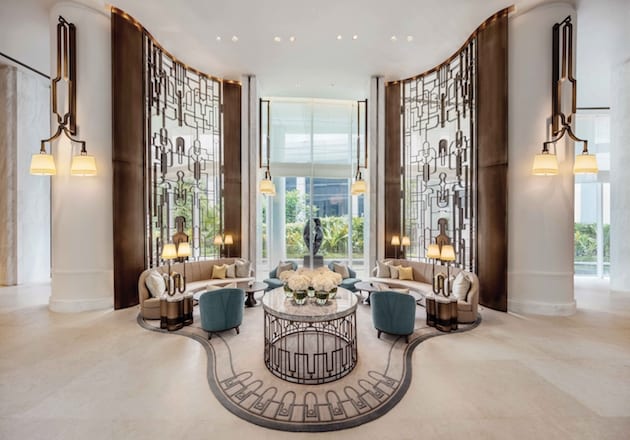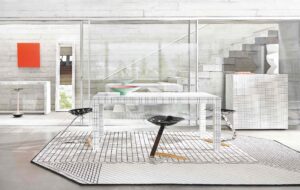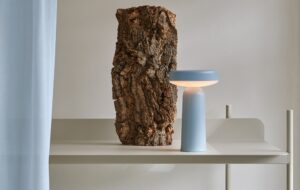 |||
|||
Skylines around the world continually transform as architects seek to reach new heights, but perhaps none has changed as dramatically as Bangkok’s. In 2014, a surge in infrastructure saw more skyscrapers erected than ever before as planners sought to elevate the city’s stature. In the same year, the imposing Magnolias Ratchadamri Boulevard building scooped the prize for Best Architectural Design at the Southeast Asia Property Awards, cutting a striking silhouette on the skyline.
The 75-storey building houses the Waldorf Astoria Hotel – the brand’s first venture into south- east Asia. Its exterior signifies a magnolia flower, with fluid lines and dramatic floor-to-ceiling windows. Inside, the 88m-high lobby is lined in Carrara marble and displays a series of burnished bronze screens in an art deco style.
A closer look reveals that the patterns mimic abstract images of dancers, much like traditional Thai décor.This fusion of quintessential 1920s style with the finger silhouettes of classical Thai dancers sets the theme for the entire hotel, conceptualised by architect André Fu.
 The grand staircase is in Carrera marble, which curves around the 88m-high lobby. Photograph: Masano Kawana.
The grand staircase is in Carrera marble, which curves around the 88m-high lobby. Photograph: Masano Kawana.
As one of the most prominent luxury designers in Asia, Fu is known for his work with Kerry Hotel Hong Kong and the Four Seasons Seoul, as well as for his Pavilion Suites at the Berkeley Hotel, London. His vision has brought together the building’s modern design with authentic Thai tradition and woven these aesthetics into the Waldorf brand.
Inspired by Fu’s memories of visiting the Waldorf Astoria in NewYork as a child, the idea was to translate the essence of that experience, which he describes as “a hotel that is visually majestic, bold in proportions and iconic in experience”, and place it in the context of modern Bangkok.
“I was also inspired by the many artisanal aspects of Thai culture,” he says, “whilst infusing these elements with what I felt evoked the quintessential Waldorf Astoria experience.” Heavily influenced by art deco motifs, Fu set himself the task of juxtaposing these elements into “a new form of expression in the hotel”.
 An infinity pool allows for views over Bangkok’s skyline. Photograph: Masano Kawana.
An infinity pool allows for views over Bangkok’s skyline. Photograph: Masano Kawana.
His efforts can be recognised in the 110-seat Brasserie restaurant on the 16th floor. This luxury dining space features an arched walkway connecting two elongated seating areas, which curl around the lines of the Magnolias’ curved structure.
The hotel itself occupies 13 levels of the building, which was conceived by US architecture firm Gensler to evoke the petals of a magnolia flower. Fu took this concept and interpreted the innocence of the magnolia into the hotel’s fixtures and fittings.
“I sought to translate its purity into the extensive use of white marble, and to transform such a tactile and solid material into something that is soft.” Fu explains that the layered silhouette of the building’s “petal” is best exemplified in the design of the spa, with its immersive corridor and outdoor infinity pool, offering sweeping views of the city.
With 171 rooms, the Waldorf Astoria Bangkok is neither the smallest nor the largest hotel Fu has designed. Known for creating “home from homes”, Fu has managed to form an intimate sense of space in a vast building.
 The hotel’s Royal Suite has a warm palette and a sense of order. Photograph: Masano Kawana.
The hotel’s Royal Suite has a warm palette and a sense of order. Photograph: Masano Kawana.
“The Waldorf is housed in a highly organic building, and I have deliberately carved each destination within the property to provoke a sense of intimacy”, he says. “The residential quality is perhaps most evident with the extent of suspended fabric lanterns that we have introduced throughout – the glow that it evokes remains a key visual linkage amongst spaces.”
It is this sense of space that Fu values above all else, with the “structural quality of the space” being his favourite feature. “The way the entire hotel is conceived is as a journey that flows,” he says.This particular journey takes the user through a maze of time periods, conceptualised in the deconstructed version of the original Waldorf clock. In the Waldorf Astoria NewYork, the 3m tall bronze clock with a carved mahogany base was a gift from Queen Victoria to America in 1839. Commissioned by the Goldsmith Company of London, the clock is now an emblem of the Waldorf brand, prominently displayed in the grand lobby.
Fu took elements of this clock and created a dissected version to hang in the Peacock Alley at the Waldorf Astoria Bangkok, and extended the use of mahogany to the sculpted figures in the Champagne Bar.
One of the challenges that Fu and his team faced was to instil the Waldorf ’s archetypal art deco design into such a contemporary building. He was also keen to weave artisanal Thai essence into his concept to ensure a grounded sense of tradition.
 Fu’s design mixes Thai influences with art deco. Photograph: Masano Kawana.
Fu’s design mixes Thai influences with art deco. Photograph: Masano Kawana.
“As we aim to infuse the art deco spirit into a space which is typically built in rectilinear spaces, the curvilinear architecture did provoke key challenges. However, the theatre of the experience is somewhat a result of the two different components and the emotions that their juxtaposition provokes,” he explains. This “juxtaposition” is one of Fu’s greatest achievements, with both themes flowing confidently throughout the hotel.
Thai history is intertwined into every aspect of the hotel, including the dramatic chandelier – made from over 800 hand-cast glass feathers – which represents the mythical Garuda bird. According to legend, the bird kills snakelike Nagas, seen in the serpentine shapes of the wooden structure.Timber carvings made by local artisans can be spotted throughout the hotel, echoing Fu’s determination to put authenticity at the heart of his creation, his vision echoing the qualities he enjoys most about Bangkok – “its creative energy and the passion to innovate”.
“My goal was to transport the very original Waldorf Astoria spirit and create something that was context-specific to Bangkok. It is never an imitation – the conception process has been meticulous and the curation process highly considered.”
Fu’s affinity with storytelling is a metaphor for the way in which he designs. Each sentence, paragraph, and chapter are bound together to create a narrative. He divulges that the Waldorf Astoria Bangkok’s story is “about a modern expression of the Thai artisanal spirit – the notion of how the legendary Waldorf Astoria spirit could be celebrated in modern Bangkok today” – and this is certainly punctuated in the discourse he has created for his latest design achievement.




















